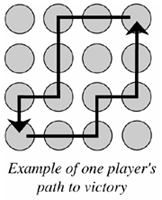 Q-Turn
Rules of Play
Q-Turn
Rules of Play
Version 1.5
Overview
Q-Turn is a quick and unpredictable little game played on a
dynamic board made up of 16 wooden disks. The goal is to get your
token to the opposite corner and back again first. The disks indicate
in which directions you may move. Landing on certain spaces lets
you rotate one or all of the disks, changing the potential paths
across the board, and since you aren't allowed to pass, fate will
sometimes send you heading off in the wrong direction.
Setup and Start
Place the disks face down on the table, mix them up, then lay
them out in a 4x4 pattern. Each player chooses a token and a starting
corner. Tokens start off the board next to your corner.
The baldest player goes first. (If there aren't any bald players,
pick the person with the shortest or least amount of hair.)
Taking a Turn
On your first turn, simply move your token onto your starting
corner. Each time you move your token onto a disk that is still
face down, flip it over and rotate it to the position of your
choice (aligned with the grid). You then set your token down on
the disk and take whatever action may apply, as on a normal turn.
On subsequent turns, you may rotate in place (if you are on
a One Way arrow) or you may move your token one space, following
one of the arrows on the disk you occupy, and take the Special
Action, if any (see next section). You may not pass. You may not
move diagonally and you may not move off the board.
Special Actions
Here are the three types of disks and their properties:
 |
The Q-Turner: Whenever you land on a disk
with arrows pointing in all four directions, you MUST then immediately
rotate all revealed disks a quarter turn counter-clockwise. |
 |
The Double Arrow: Whenever you land on
this type of disk, you MAY also then rotate any one disk (other
than your own) a quarter turn counter-clockwise. |
 |
The One Way Arrow: No action is taken
when you land on this type of disk. However, if you are on such
a space at the beginning of your turn, you may choose to re-orient
that disk INSTEAD of moving your token to the indicated space.
You may re-orient the disk however you wish, as long as it doesn't
point diagonally. |
Bouncing
Each space can hold only one token. If someone occupies a space
you could potentially enter, you may choose to bounce off their
piece and remain where you are. This allows you to re-use the
special action associated with your space, just as though you
had landed on it for the first time.
You may only bounce off of an occupied space on the board;
you may not bounce against the edge of the board.
 Winning
Winning
The object of the game is to move your token from the disk
you started on across the board to the disk in the opposite corner,
and back again. As soon as someone completes that journey and
moves his or her token back onto their starting disk, the game
ends and that player wins.
Turn Order
In keeping with the direction of disk rotation on the four-way
and two-way arrows, play proceeds counter-clockwise from the starting
player.
Strategies
It's very important to plan ahead when deciding how to orient
a disk. If you anticipate that one of the other players will land
on a Q-Turner next, you will want to compensate for this rotation
by pointing your disk a clockwise turn away from the direction
you really want to move.
The most direct path across the board would be along the diagonal,
but since you can't do that, you frequently have to decide whether
to point to the left or the right. Usually it's better to go to
the right that way, you'll still be able to make progress
across the board, even it someone hits a Q-Turner and the disk
ends up pointing to the left.



 Q-Turn
Rules of Play
Q-Turn
Rules of Play
 Winning
Winning



